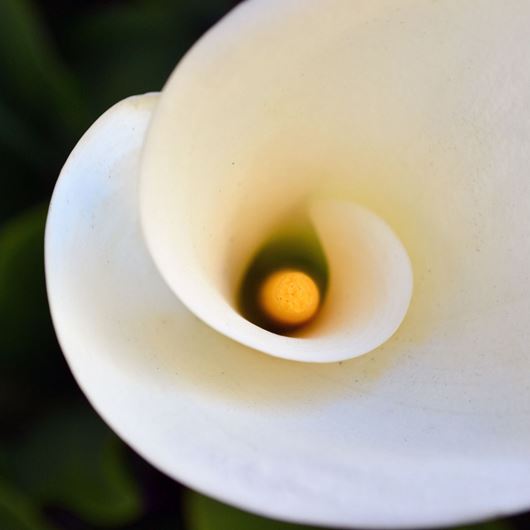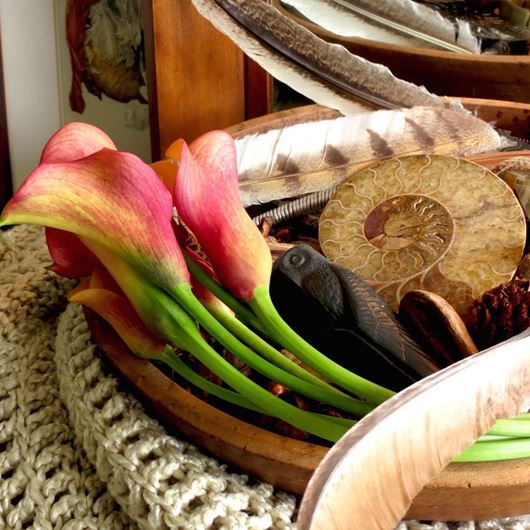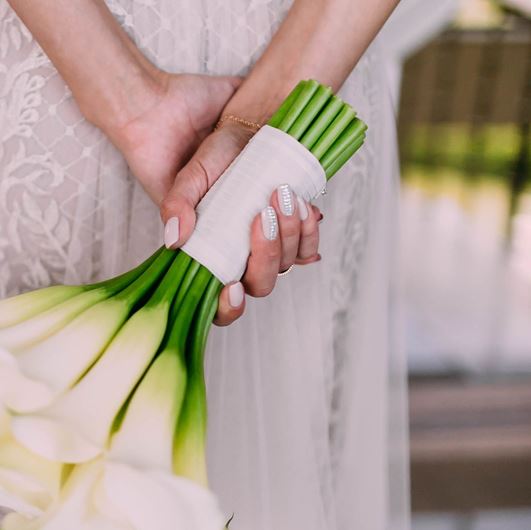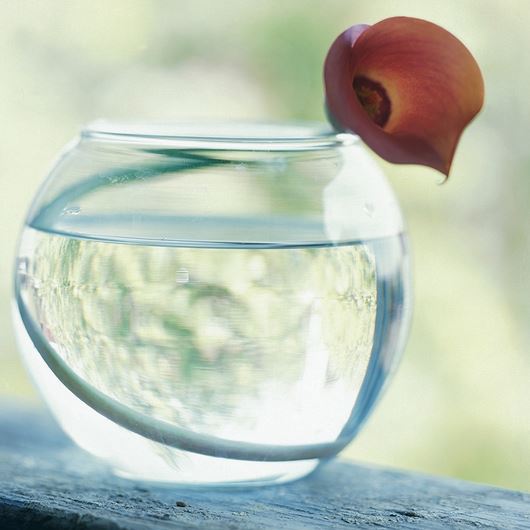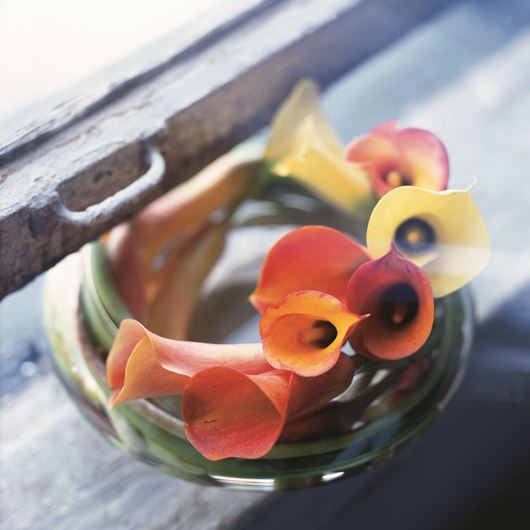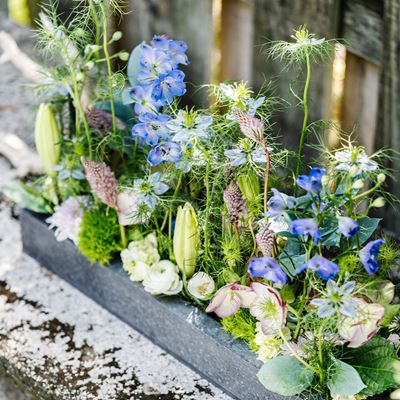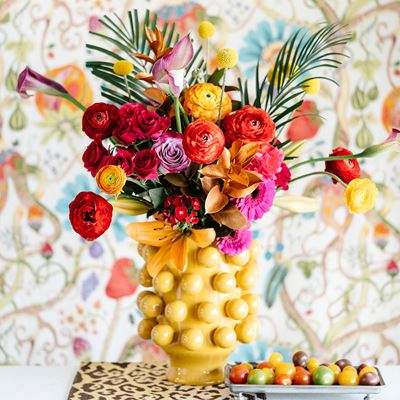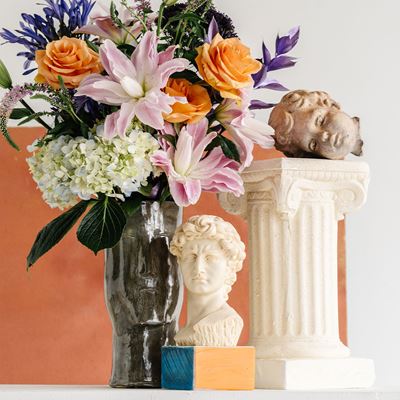Completing our 2023 lookbook series, our sixth and final trend, ATMOSPHERIC, pays homage to our planet's habitats at large. This trending macro view gathers an immersive palette of cool hues, borrowed from the oceans and forests, and pairs it with glowing bright white.
The Mixed-up, Misnomered, Misunderstood Persona of the Wildly Attractive Calla
The simple elegance of this classic flower may not be as simple as it seems. First, it’s not actually a calla. Nor is it a lily. That single, dramatic petal? Well, it’s not a petal either. And that fleshy pistil sticking up in the middle? You're catching on, it isn’t a pistil.
Is it even a flower, then? Indeed it is! Callas are perennial herbs which grow 8 - 30" (20 - 76 cm) leafy stems from rhizomes. The 1 - 6" (2.5 - 15 cm) rolled-satin “petal” at the end of each stem is actually the flower’s spathe, or protective sheath. It shields the true flowers, which are tiny, numerous, and clustered all around the finger-like spadix in the eye of the funnel.
Classic giant or winter callas (Zantedeschia aethiopica) have sturdier stems and larger blooms, and are usually white, green or pastel pinkish-lavender. Mini or summer callas (Zantedeschia hybrids) are smaller with more slender stems and a rainbow of brilliant colors.
Renaissance European botanists mistook them for lilies, and later botanists discovered that they were related to the calla family but distinct enough to require their own genus, Zantedeschia. Unlike true lilies, their pollen does not stain, they have no fragrance and they are not sensitive to ethylene exposure. They don’t give off much ethylene themselves, either. Callas may be dried using a desiccant such as silica gel and a lot of patience.
SPECIAL CARE
Handle gently, as the lush spathes and stems are easily bruised. Choose long, sturdy, unblemished stems, with each flower open enough for the thick yellow spadix in the center to be showing. Flowers rolled too tightly are not likely to open properly.
Callas don’t need to be pretreated; simply recut stems and place in a preservative with a bactericide and preferably without sugar. Flower foods with sugar won’t harm the blossoms, but they won’t help them much either, and sugar will encourage bacterial growth. This can lead to stem block and splitting, both of which impede hydration for these water-loving plants. So if you are preparing a callas-only presentation, pass on the sugar, while keeping buckets clean and replenished.
Try to use callas immediately and keep at room temperature, but if they must be stored, keep them at about 35ºF (1.7ºC). Mini callas need a bit warmer temperature; up to 46ºF (8ºC). Lower temperatures can cause chill damage.
For potted callas, choose containers with about half the flowers beginning to show color. Keep the soil moist, but not soggy. Display in a cool spot with good air circulation and bright, indirect light.
FUN FACTS
• These plants are such common roadside weeds in South Africa that they are called varkoor, which means “pig’s ear” in the Afrikaans language.
• They’re not lilies! Early European aficionados mistook them for lilies because of their trumpet-shaped silhouette and similar warm-weather blooming season, and the name stuck. Zantedeschia (calla lilies) and Lilium (true lilies) are completely unrelated.
• Sigmund Freud ascribed complex unconscious meanings to the calla; it’s not difficult to guess what they were about.
• Artist Georgia O’Keefe became famous in the 1930s for her larger-than-life, extreme close-up views of flowers. She painted callas so frequently that she was nicknamed “lady of the lilies.”
• Some calla cousins, including taro, are food crops. Not callas themselves, though! They are full of toxic oxalic acid crystals, which sting and burn like microscopic needles if consumed, and the raw juice can cause rashes on the skin.
• Legendary Swedish botanist Carl Linnaeus grouped these flowers into the genus Calla in the 18th century, but as the next generations learned more, it became clear that the flatter-blossomed true calla was a different genus from its coiled-scroll cousin. So in the 1820s, German botanist Karl Koch separated and named the new genus after fellow botanist Giovanni Zantedeschi. Yet by then the name “calla lily” was entrenched, and still remains the common name for the genus Zantedeschia.
• The Zantedeschia genus includes 28 species, all native to the tropics of the southern third of the African continent. Six of those species are the parents of the hundreds of brilliant hybrid cultivars that florists and their customers enjoy today. Colors include whites and creams, pinks, reds, oranges, yellows, greens, purples
• It’s a mystery when callas first made their way to Europe, but there were documented specimens growing at the Royal Gardens of Paris in the late 1600s.
• Callas grow agreeably with a bit of warmth and water, so they have brightened centuries of European winters by blooming in greenhouses. Their ready availability at Christmas and Easter holidays, combined with their flawless white appearance, created an association between callas and Christian figures.
• Like the Madonna lily, white callas are traditional icons for divine mother-love in the Christian tradition. They represent the Virgin Mary and her “white without and golden within” purity of body and radiance of spirit.
• Since callas were mistakenly identified as lilies, many of the older myths surrounding true lilies were also applied to callas. A Greek myth tells of their first blossoms appearing when Zeus, king of the gods, tried to amp up the divine powers in his half-human love child, Hercules, by tricking his queen-goddess wife Hera into nursing the baby. When Hera wised up, she angrily tossed baby Hercules across the sky, with her milk streaming after him to become the Milky Way. The drops which fell to earth became lilies, a self-renewing reminder to humans of Hera, the goddess of earth, moon, women, marriage and childbirth.
• To the Romans, lilies symbolized their own queen goddess, Juno, who also ruled marriage and motherhood, as well as the light and the heavens. The same meaning applies to callas as well.
• In the Victorian “Language of Flowers,” callas symbolize perfect beauty. Individual colors also have specific meanings.
Callas are only one of the Flowers We Love, and we would love to share them all with you. Whether flowers are your passion or your profession, this living encyclopedia will expand your knowledge and entice your imagination. Visit often as we add entries to keep your floral skills growing.
